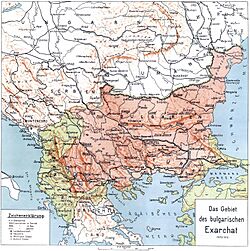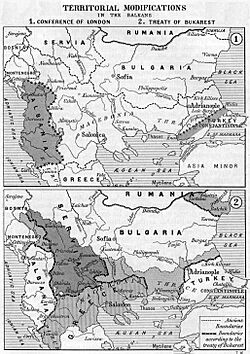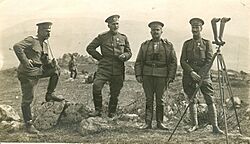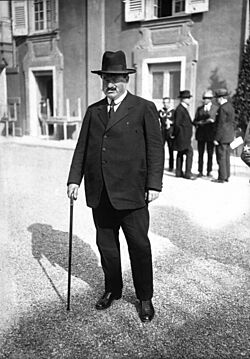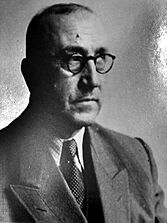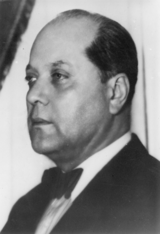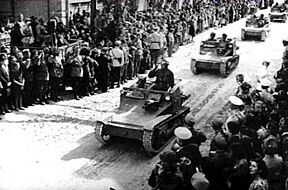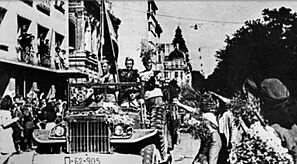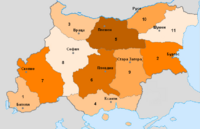Tsardom of Bulgaria (1908–1946) facts for kids
Quick facts for kids
Tsardom of Bulgaria
Царство България
Tsarstvo Bǎlgariya |
|||||||||||||
|---|---|---|---|---|---|---|---|---|---|---|---|---|---|
| 1908–1946 | |||||||||||||
|
Anthem: Шуми Марица
Shumi Maritsa Maritsa Rushes (1886–1946) Royal anthem: Химн на Негово Величество Царя
Himn na Negovo Velichestvo Tsarya ("Anthem of His Majesty the Tsar") |
|||||||||||||
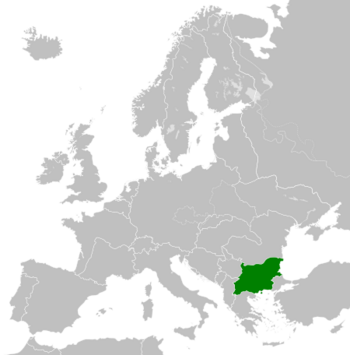
The Tsardom of Bulgaria in 1942
|
|||||||||||||
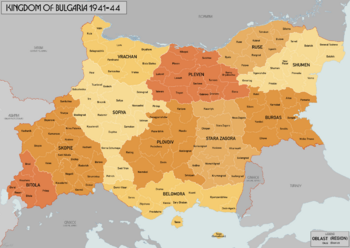
Administrative divisions of the Tsardom of Bulgaria in 1942
|
|||||||||||||
| Capital and largest city
|
Sofia | ||||||||||||
| Official languages | Bulgarian | ||||||||||||
| Religion | Bulgarian Orthodox Church (state religion) | ||||||||||||
| Demonym(s) | Bulgarian | ||||||||||||
| Government | Unitary parliamentary constitutional monarchy (1908–1935; 1943–1946)
(1935–1943) (de facto) |
||||||||||||
| Tsar | |||||||||||||
|
• 1908–1918
|
Ferdinand | ||||||||||||
|
• 1918–1943
|
Boris III | ||||||||||||
|
• 1943–1946
|
Simeon II | ||||||||||||
| Chairman of the Council of Ministers | |||||||||||||
|
• 1908–1911 (first)
|
Aleksandar Malinov | ||||||||||||
|
• 1944–1946 (last)
|
Kimon Georgiev | ||||||||||||
| Legislature | National Assembly | ||||||||||||
| History | |||||||||||||
|
• Independence declared
|
5 October 1908 | ||||||||||||
| 1912–1913 | |||||||||||||
|
• Treaty of Bucharest
|
10 August 1913 | ||||||||||||
|
• World War I
|
1915–1918 | ||||||||||||
| 27 November 1919 | |||||||||||||
|
• Coup d'état
|
9 June 1923 | ||||||||||||
|
• Coup d'état
|
19 May 1934 | ||||||||||||
|
• Counter-coup by Boris III
|
1935 | ||||||||||||
|
• Treaty of Craiova
|
7 September 1940 | ||||||||||||
|
• Coup d'état
|
9 September 1944 | ||||||||||||
|
• Monarchy abolished
|
15 September 1946 | ||||||||||||
| Area | |||||||||||||
| 1915 | 122,134 km2 (47,156 sq mi) | ||||||||||||
| Population | |||||||||||||
|
• 1915
|
4,580,000 | ||||||||||||
| Currency | lev | ||||||||||||
| ISO 3166 code | BG | ||||||||||||
|
|||||||||||||
| Today part of | |||||||||||||
The Tsardom of Bulgaria (Bulgarian: Царство България, romanized: Tsarstvo Bǎlgariya), also known as the Third Bulgarian Tsardom, was a country in Southeastern Europe. It was a constitutional monarchy, which means it had a king (called a Tsar) but also a government and laws that limited the king's power. It was created on October 5, 1908, when Bulgaria changed from a principality (a smaller state ruled by a prince) into a tsardom.
Ferdinand, who started the royal family, became the first Tsar. He wanted to unite all lands with many ethnic Bulgarians in the Balkans region. These lands had been taken from Bulgaria and given to the Ottoman Empire in the Treaty of Berlin. Other countries saw Ferdinand and the later Bulgarian Tsars as kings.
Bulgaria was often involved in wars during its existence, earning it the nickname "the Balkan Prussia". In the 1910s, Bulgaria fought in three major wars: the First and Second Balkan Wars, and World War I. After World War I, Bulgaria's army was disbanded, and its plans to unite Bulgarian lands failed.
Less than 20 years later, Bulgaria joined the Axis Powers in World War II. It was again on the losing side until it switched to the Allies in September 1944. In 1946, the monarchy was ended, the last Tsar, Simeon II, went into exile, and Bulgaria became the People's Republic of Bulgaria.
Contents
- Bulgaria's Journey: A Historical Overview
- Changing Borders: Bulgaria's Territory Over Time
- People and Society: Demographics and Education
- Economy: Farming and Industry
- Images for kids
- See also
Bulgaria's Journey: A Historical Overview
Becoming an Independent Kingdom

Even though the Principality of Bulgaria was formed in 1878, many Bulgarians still lived under Ottoman rule, especially in Macedonia. Other countries like Serbia and Greece also wanted parts of Macedonia. This led to a struggle for control that lasted until World War I. In 1903, there was a Bulgarian uprising in Ottoman Macedonia.
In 1908, Tsar Ferdinand took advantage of problems between the Great Powers to declare Bulgaria a fully independent kingdom. He did this on October 5 (though celebrated on September 22) in the St Forty Martyrs Church in Veliko Tarnovo. Bulgaria had already been acting mostly independent since 1878, with its own constitution, flag, and foreign policy.
Ferdinand chose the title "Tsar" to honor the rulers of the First and Second Bulgarian Empires. However, outside Bulgaria, he and his successors were called "kings." The country's constitution was kept, but the word "prince" was changed to "tsar."
The Balkan Wars: Fighting for Land
First Balkan War: Allies Against the Ottomans
In 1911, Prime Minister Ivan Geshov formed alliances with Greece and Serbia. These three countries agreed to work together to attack the Ottomans.

In 1912, Bulgaria signed secret agreements with Serbia and Greece. These agreements were meant to divide Macedonia and Thrace among them. When the Ottomans refused to make changes in these areas, the First Balkan War began in October 1912.
The allies were very successful. The Bulgarian army defeated Ottoman forces and moved close to Constantinople. The Serbs and Greeks took control of Macedonia. The Ottomans asked for peace in December. After more fighting, the Ottomans lost all their European lands west of a certain line near Istanbul. Bulgaria gained most of Thrace, including Adrianople and the Aegean port of Dedeagach (now Alexandroupoli). Bulgaria also got a part of Macedonia.
Second Balkan War: Allies Turn Against Bulgaria
Bulgaria had the most casualties among the allies and felt it deserved the biggest share of the new lands. But Serbia disagreed, refusing to leave the territories they had taken in northern Macedonia. They said Bulgaria hadn't met its war goals. Some in Bulgaria wanted to go to war with Serbia and Greece over this. In June 1913, Serbia and Greece formed a new alliance against Bulgaria.
Tsar Ferdinand declared war on Serbia and Greece, and the Bulgarian army attacked on June 29. The fighting was very harsh. Soon, Romania attacked Bulgaria from the north, and the Ottoman Empire attacked from the southeast. Bulgaria lost the war. It had to give up most of its claims in Macedonia to Serbia and Greece. The Ottomans took back Adrianople, and Romania took southern Dobruja.
World War I: A New Alliance=
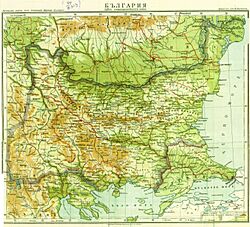
After the Balkan Wars, many Bulgarians felt let down by Russia and the Western powers. Bulgaria stayed neutral at first in World War I.
Under Prime Minister Vasil Radoslavov, Bulgaria joined Germany and Austria-Hungary. This meant becoming allies with the Ottomans, who were Bulgaria's old enemies. However, Serbia, Greece, and Romania (allies of the UK and France) held lands that Bulgaria considered its own. Germany promised to help Bulgaria get back lost territories. So, in October 1915, Bulgaria declared war on Serbia. Then, the UK, France, Italy, and Russia declared war on Bulgaria.
Bulgaria, allied with Germany, Austria-Hungary, and the Ottomans, won battles against Serbia and Romania. They took much of Macedonia and parts of Romania. However, the war quickly became unpopular in Bulgaria. People faced hard times and didn't like fighting against fellow Orthodox Christians while allied with the Muslim Ottomans. Aleksandar Stamboliyski, a leader who opposed the war, was put in prison.
The Russian Revolution in 1917 spread anti-war feelings in Bulgaria. In September 1918, the Allies broke through the front lines. Tsar Ferdinand had to seek peace. To prevent a revolution, he stepped down, and his son, Boris III, became Tsar. The army was disbanded.

Under the Treaty of Neuilly-sur-Seine (November 1919), Bulgaria lost its Aegean coastline to Greece, parts of Macedonia to the new Kingdom of Yugoslavia, and Southern Dobruja went back to Romania. The army was limited to 20,000 men, and Bulgaria had to pay a lot of money in reparations. Bulgarians called this the "Second National Catastrophe." In elections in March 1920, Stamboliyski's party won, forming Bulgaria's first truly democratic government.
The Years Between the Wars
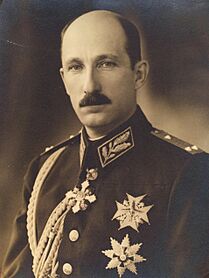
After World War I, Bulgaria lost important land, including its access to the Aegean Sea. The 1879 constitution wasn't clear about the powers of the king and Parliament. While Parliament was meant to have most power, a clever king could still take control. Tsar Ferdinand did this, but he had to step down after the war losses. His son, Boris, became Tsar, but he didn't have the same political power as his father.
Stamboliyski's Government: Helping Peasants
Parliament gained more power when Boris appointed Aleksandar Stamboliyski as prime minister. Stamboliyski's Agrarian Party, which represented farmers, soon controlled Parliament. They passed a land reform law in 1920 to break up large landholdings and sell them to poor farmers. This was very popular.
Stamboliyski faced many challenges in a poor country mostly made up of small farmers. Bulgaria had to pay large war reparations and deal with refugees. Despite this, he brought in many social reforms, even with strong opposition from the Tsar, landowners, and the army. He also faced the Internal Macedonian Revolutionary Organization (VMRO), which wanted war to regain Macedonia.
Stamboliyski made big economic changes. He ended the grain monopoly and sold land to the poor. He also made labor compulsory and introduced a progressive income tax. In foreign policy, he gave up Bulgaria's claims to lost territories and sought peace with other European countries. He wanted to create a Balkan Peasants' Federation.
Stamboliyski was against communism and tried to create an international movement of farmers. He was liked in Yugoslavia because he supported a peaceful solution to the Macedonia issue. However, the militant IMRO group caused problems. Many Macedonian leaders moved to Sofia and gained control of the border area with Yugoslavia.
The new peaceful policy worried nationalists. Workers who didn't benefit from the land reforms turned to Communists. In 1922, Stamboliyski arrested leaders of the National Alliance. But Macedonian nationalists seized Kyustendil and attacked government officials. Stamboliyski responded with mass arrests and called for new elections. This united his opponents, including IMRO, the National Alliance, and army groups. In June 1923, IMRO agents killed Stamboliyski, and the conspirators took control of the country.
Changes in Government: Tsankov and Lyapchev
In March 1923, Stamboliyski signed an agreement with Yugoslavia, recognizing the new border and agreeing to stop IMRO. This angered nationalists. On June 9, 1923, the army, led by General Ivan Valkov, staged a coup. They had support from the Tsar and other right-wing groups. Stamboliyski was killed, and a right-wing government led by Aleksandar Tsankov took power.
The September Uprising began in 1923 when Stamboliyski's supporters tried to regain power but were quickly stopped by the army. Tsankov's government arrested many suspected communists. Uprisings in northwestern Bulgaria were quickly put down.
After two failed attempts on the Tsar's life, including a bomb attack on Sofia Cathedral in 1925, there was harsh repression. But in 1926, Boris persuaded Tsankov to resign. A more moderate government under Andrey Lyapchev took over. An amnesty was declared, though Communists remained banned.
Lyapchev was more forgiving towards political opponents. The Communists reappeared as the Bulgarian Workers' Party. The IMRO also had more freedom, leading to continued political assassinations and terrorism. IMRO raids into Yugoslavia hurt Bulgaria's relations with that country. The late 1920s brought more political stability. The economy improved, and foreign investment grew. Bulgaria also improved its international image by joining the League of Nations.
Authoritarian Rule Begins: The 1934 Coup
The Great Depression hit Bulgaria hard, causing social tensions to rise again. In May 1934, the military group Zveno staged another coup. An authoritarian government led by Colonel Kimon Georgiev was set up. They banned all political parties and trade unions and suppressed the IMRO. They tried to create an economy similar to Italy's under Mussolini. Zveno wanted to ally with France and unite Bulgaria into a larger Yugoslavia.
In April 1935, Boris III staged a counter-coup and took power himself. He controlled the political process, but a form of parliamentary rule was brought back. However, political parties remained banned, and the Tsar appointed prime ministers. Bulgaria entered a period of prosperity and growth, known as the Golden Age of the Third Bulgarian Kingdom, under Prime Minister Georgi Kyoseivanov. His government made agreements with Yugoslavia and Greece and began rearming the military.
World War II: Shifting Alliances
When World War II began, Bulgaria's government declared neutrality. It hoped to gain back lost territories peacefully. However, Bulgaria's location in the Balkans meant it faced pressure from both sides of the war. On February 15, 1940, Bogdan Filov, who was pro-German, became Prime Minister. On September 7, 1940, Bulgaria successfully negotiated to get Southern Dobruja back through the Treaty of Craiova, supported by the Axis Powers. Bulgaria also had a non-aggression pact with Turkey.
On March 1, 1941, Bulgaria officially joined the Tripartite Pact, becoming an ally of Nazi Germany, Japan, and Italy. German troops entered Bulgaria to prepare for invasions of Greece and Yugoslavia. When Yugoslavia and Greece were defeated, Bulgaria was allowed to occupy parts of Greek Thrace and most of Macedonia. Bulgaria declared war on Britain and the United States but refused German pressure to declare war on the Soviet Union, due to strong pro-Russian feelings in the country.
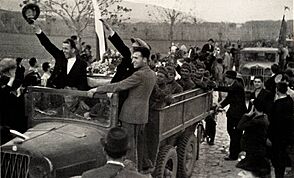
In August 1943, Tsar Boris died suddenly. His six-year-old son, Simeon II, became Tsar. Power was held by a council of regents. The new prime minister, Dobri Bozhilov, was largely controlled by Germany. Resistance to the Germans and the Bulgarian government grew by 1943, led mainly by the Communists. They formed the Fatherland Front with other groups.
By 1944, it was clear Germany was losing the war. The Bulgarian government tried to find a way out. In August 1944, Bulgaria announced it was leaving the war and asked German troops to leave. Bulgarian troops quickly pulled out of Greece and Yugoslavia. In September, the Soviets crossed Bulgaria's northern border. The government, desperate to avoid Soviet occupation, declared war on Germany. But the Soviets declared war on Bulgaria on September 8. For a few days, Bulgaria was at war with both Germany and the Soviet Union. The Soviet Union occupied northeastern Bulgaria and key port cities. On September 16, the Red Army entered Sofia.
The Holocaust: Protecting Bulgarian Jews
The Holocaust in Bulgaria involved the persecution of Jews between 1941 and 1944. This was done by the Nazi Germany-allied government of Tsar Boris III and Prime Minister Bogdan Filov. The persecution began in 1941 with anti-Jewish laws. In March 1943, almost all 11,343 Jews living in Bulgarian-occupied parts of Greece and Yugoslavia were arrested and sent to extermination camps in German-occupied Poland.
Plans to deport the 48,000 Jews from Bulgaria itself began but were stopped due to widespread protests. Members of Parliament, led by Dimitar Peshev, pressured the interior minister to cancel the deportation order. Public protests and actions by important figures, especially Bulgarian Orthodox Church bishops Stefan of Sofia and Kiril of Plovdiv, convinced the Tsar to stop the deportation temporarily in March 1943, and then postpone it indefinitely.
The Jews whose deportation from Bulgaria was stopped were instead moved to the countryside, and their property was taken. Jewish men aged 20 to 46 were forced to work in labor camps until September 1944. These events, which prevented the deportation of about 48,000 Jews in spring 1943, are known as the "Rescue of the Bulgarian Jews." As a result, the survival rate of Jews in Bulgaria was one of the highest in Axis Europe.
Communist Takeover: End of the Monarchy
The Fatherland Front took power in Sofia after a coup d'état. They formed a broad government. Bulgaria was allowed to keep Southern Dobruja but gave up all claims to Greek and Yugoslav territory. Many Bulgarians were forced to leave Greek Thrace. At first, the Communists played a small role in the new government, but Soviet representatives held the real power. A Communist-controlled People's Militia was set up to intimidate non-Communist parties.
The new power in Bulgaria became clear when former regents and hundreds of other officials from the old government were arrested for war crimes and executed on February 1, 1945. In September 1946, the monarchy was ended by a public vote. This vote went against the old constitution. The republic was officially declared a week later, and the young Tsar Simeon was forced into exile. The Communists then openly took power. Vasil Kolarov became president, and Georgi Dimitrov became prime minister. Elections promised for 1946 were rigged, and the opposition boycotted them. The Agrarians refused to work with the new government, and their leader Nikola Petkov was arrested and executed in September 1947. This led to the creation of a Communist regime in Bulgaria.
Changing Borders: Bulgaria's Territory Over Time
Bulgaria's borders changed many times from its independence until the Communist era. Before the First Balkan War, Bulgaria did not control parts of the Rhodope Mountains. After that war, Bulgaria gained the most territory, including eastern Macedonia, Greek Thrace, and Adrianople.
However, its desire for more of Macedonia led to the Second Balkan War, which Bulgaria lost badly. It lost all its gains from the previous war and also lost Southern Dobruja to Romania. It still kept Western Thrace and the Western Outlands.
During World War I, Bulgaria joined the Central Powers in 1915. It gained a lot of land from Serbia, including Macedonia. But after losing the war, Bulgaria lost its Aegean coast and the land it had gained from Serbia.
During the period between the two World Wars, there were no border changes, except for a small conflict called the Incident at Petrich. When Bulgaria joined the Axis powers in World War II, it again gained a coastline to the Aegean and Macedonia. After the Soviet invasion in 1944, Bulgaria got Southern Dobruja back.
People and Society: Demographics and Education
Who Lived in Bulgaria?
About 85% of the population were ethnic Bulgarians, so there wasn't much conflict between different ethnic groups. Most people in Sofia (the capital) still had strong ties to the countryside. However, there was a divide between city people and farmers. About 14% of the population were Muslims, mostly Turks, but also some "Pomaks" (ethnic Bulgarians who practiced Islam). Muslims felt different from the main Orthodox Christian population due to religion and history.
Learning and Schools: Education in the Tsardom
In 1909, a year after Bulgaria became independent, a law changed the education system. After World War I (1919–1923), education faced difficulties. The main goal of the Ministry of Education was to get schools working normally again. Lower secondary school became a junior school with a three-year course. Compulsory education became mandatory for children aged 7–14, but only for primary school. High schools were also established.
After the 1923 coup, education changed again. Students had to pass entrance exams to go from primary to secondary school. Religion also became a required subject in high school.
Bulgaria's education system was quite successful compared to its economy. Less than half the population couldn't read or write. Eight years of schooling were required, and over 80% of children attended. For students who went past elementary school, high schools were similar to German gymnasiums. Bulgaria had several technical schools and the University of Sofia. Many Bulgarian students also studied abroad, mostly in Germany and Austria. Education reached more lower-class people than in other parts of Eastern Europe. However, many students studied subjects that didn't lead to jobs outside of government.
Economy: Farming and Industry
Economic Overview: A Rural Nation
At the start of the 20th century, Bulgaria was a rural country. It was mostly based on farming, not very industrialized, and economically behind. Wars and losing land made economic development difficult. About 37.8% of the population were farmers. In 1910, only 19.1% of people lived in cities, a number that hadn't changed much since independence.
Literacy rates were low: in 1900, it was 58% in Sofia, 40% in other cities, and 15% in rural areas. Bulgarian industry was mostly about textiles, food, and drinks. These made up almost 90% of all factory production in 1911. Bulgarian industry was also not very efficient.
In 1910, Bulgaria's economic output per person was very low, the lowest in Europe. The Balkan Wars cost a lot of money. Foreign trade dropped sharply in 1913. Before the war, grain was a main export, especially from Dobruja. The government built railways to carry grain to the port of Varna. By 1938, Bulgaria's economic output per person had increased, putting it ahead of some other European countries. However, by 1939, most of the country's income still came from agriculture. The unstable political situation made Bulgaria one of the poorest countries in Europe.
Key Economic Areas: Farming and Factories
Bulgarian agriculture faced challenges like old technology and too many people living in rural areas. Farms were often small because land was divided equally among sons. Agricultural exports were hurt by the Great Depression. Still, the country avoided a major food crisis. Many farmers died during the wars, and the number of farm animals decreased. Losing Southern Dobruja was very damaging, as it produced 20% of Bulgaria's grain.
Despite these issues, Bulgaria didn't have much trouble with debt or inflation because its economy was not highly developed. Less than half of its industry was owned by foreign companies. Agricultural productivity was low, but farmers worked their small plots very hard. They were able to switch from growing grains to garden crops and tobacco when grain markets became difficult. By the late 1930s, Bulgaria was producing twice as much per hectare as some developed European countries. However, by 1945, most farms were small and struggled to support themselves. Many farmers were unemployed, especially in winter.
The industrial sector was weak. Between 1895 and 1928, measures were taken to help industry, like tax breaks and low shipping costs. Industrial output doubled between 1926 and 1929, mainly in textiles and electricity. But in the 1930s, many of these benefits were removed, and new businesses were almost forbidden. Existing industries remained uncompetitive. By 1941, most industry was small-scale manufacturing and handicrafts. Bulgaria was far behind leading European industrial countries.
Images for kids
See also
 In Spanish: Reino de Bulgaria para niños
In Spanish: Reino de Bulgaria para niños
- History of Bulgaria
- History of Bulgaria (1878–1946)
- Invasion of Serbia by Bulgaria during the First World War




